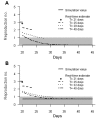Real-time estimates in early detection of SARS
- PMID: 16494726
- PMCID: PMC3293464
- DOI: 10.3201/eid1201.050593
Real-time estimates in early detection of SARS
Abstract
We propose a Bayesian statistical framework for estimating the reproduction number R early in an epidemic. This method allows for the yet-unrecorded secondary cases if the estimate is obtained before the epidemic has ended. We applied our approach to the severe acute respiratory syndrome (SARS) epidemic that started in February 2003 in Hong Kong. Temporal patterns of R estimated after 5, 10, and 20 days were similar. Ninety-five percent credible intervals narrowed when more data were available but stabilized after 10 days. Using simulation studies of SARS-like outbreaks, we have shown that the method may be used for early monitoring of the effect of control measures.
Figures


References
-
- Leung GM, Hedley AJ, Ho LM, Chau P, Wong IO, Thach TQ, et al. The epidemiology of severe acute respiratory syndrome in the 2003 Hong Kong epidemic: an analysis of all 1,755 patients. Ann Intern Med. 2004;141:662–73. - PubMed
Publication types
MeSH terms
LinkOut - more resources
Full Text Sources
Miscellaneous
